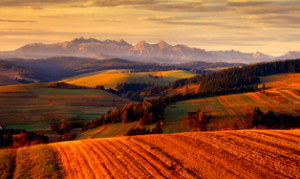Małopolska is a dynamically developing region with a considerable economic potential that promises reliable economic growth. It provides a friendly, competitive and attractive area of operation for entrepreneurs.
The region is inhabited by 3.33 million people (2011 National Census: 8.7 percent of Poland’s population, 4th place in Poland) and is characterised by a constant high population growth rate. It also attracts people from other regions. Only in 2011, the number of inhabitants increased by 4.3 thousand.


Małopolska, which covers the area of 15,200 km2, and its capital – Krakow, are one of the most beautiful areas in Central Europe. This is proven by 8–10 million tourists a year who discover the historic sights of the former capital of Poland, the magnificent landscapes of the Tatra Mountains, Podhale and Pieniny, the traditions of the Wieliczka Salt Mine, the tragic events in the 20th century history of Auschwitz, the home of John Paul II in Wadowice, castles, wooden historic architecture, national parks and nature reserves.
Małopolska has the greatest number of objects listed among the UNESCO World Cultural and Natural Heritage Sites. As many as 14 Polish objects are located in the Malopolska Region: the Old Town in Krakow, the Royal Salt Mines in Wieliczka and Bochnia (1987, 2013), KL Auschwitz-Birkenau, the monastery in Kalwaria Zebrzydowska, wooden churches in southern Małopolska – Binarowa, Blizne, Dębno Podhalańskie, Haczów, Lipnica Murowana, Sękowa and churches within a group of wooden Orthodox church complexes (since 2013).
The region borders the Slovak Republic (982 km of shared border). Next to Krakow, other important cities in Małopolska include: Tarnów (118 thousand), Nowy Sącz (85 thousand), Oświęcim (43 thousand), Chrzanów (40 thousand), Nowy Targ (33 thousand), Zakopane (27 thousand).
Małopolska is one of the best economically developing regions, which is confirmed by its high positions in rankings: „European Cities & Regions of the Future 2012/2013” (fDi Intelligence), „Atrakcyjność inwestycyjna polskich regionów 2012” (Market Economy Research Institute – IBnGR), Top 10 Emerging Outsourcing Cities List (Global Services, 2012), and reliable interest in investments on the part of the world’s largest companies dealing with industry, modern business services, manufacturing, automotive industry, commerce, science and research.
The value of Foreign Direct Investments in the years 1989–2012 amounted to ca. USD 15 billion, and the value of the regional export in the same period was ca. EUR 6 billion.
In the new 2014–2020 European Union Financial Framework, Małopolska will have nearly EUR 3 billion at its disposal allocated to the development of infrastructure, support of entrepreneurship, new technologies and improvement in the quality of the natural environment.
The most valuable assets of the region include:
• a strong academic and R&D centre based on 33 institutions of higher education in the region,
• one of the most attractive tourist destinations in Europe and in the world (Krakow, Wieliczka, Tatra Mountains, Wadowice, Auschwitz) attracting ca. 8 million tourists a year,
• high quality and availability of qualified human resources,
• convenient location at the transit routes to the East (Ukraine), West (Germany), South (Slovakia, the Czech Republic) and North (northern Poland, the Baltic Sea),
• investment infrastructure (special economic zone, economic activity zones, business environment and investor assistance institutions),
• high business culture, entrepreneurship and openness to international contacts.


